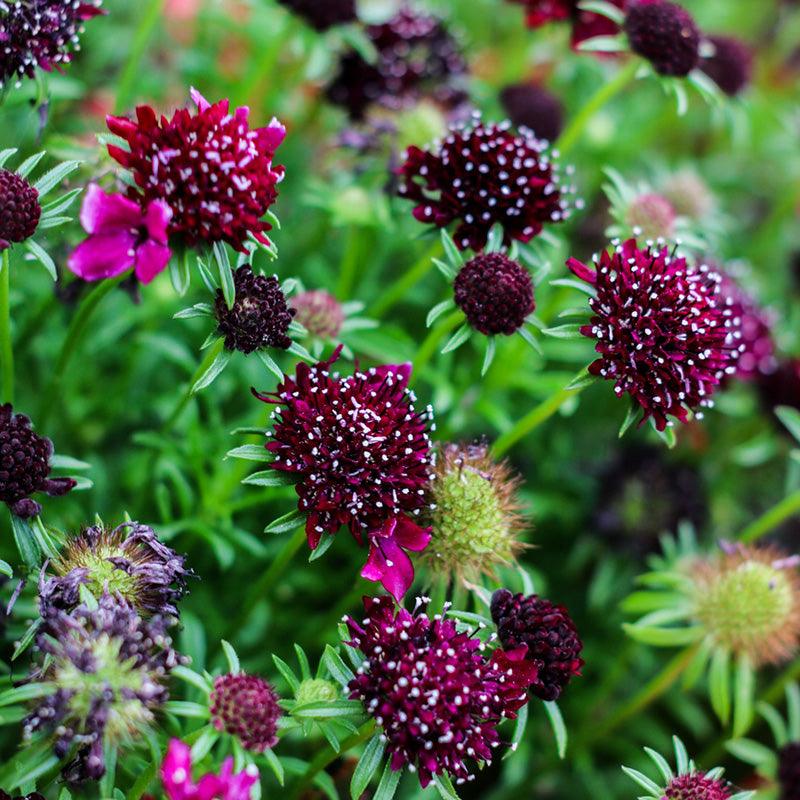Item Number: PV138
Organic Scabiosa Mix
Artful Arrangements, Timeless Dried Beauty
Known as the pincushion flower, Scabiosa boasts a delicate look with whimsical, frilly petal skirts and slender, wiry stems—ideal for cutting and arranging in bouquets. With a prolonged blooming period and decent drought tolerance, these flowers make a superb addition to pollinator gardens, attracting bees and butterflies, while also enhancing mixed borders or rock gardens.
Sustainably grown in 2.75" pots
Selecting the Right Location
Scabiosa thrives in full sun to partial shade. Choose a location in your garden that receives at least 6 hours of sunlight daily. Ensure that the soil is well-draining and fertile, as Scabiosa prefers moist, loamy soil with good organic content.
Planting Scabiosa
Plant Scabiosa starts after the last frost. Plant them at the same depth as they were in their containers. Water thoroughly after planting to help the roots establish in the soil.
Watering and Care
Scabiosa plants require regular watering to keep the soil evenly moist, especially during dry periods. Water at the base of the plant to avoid wetting the foliage, which can lead to disease. Apply a layer of mulch around Scabiosa plants to help retain soil moisture and suppress weeds.
Fertilizing
Scabiosa is not a heavy feeder but can benefit from occasional fertilization to promote healthy growth and abundant flowering. Apply a balanced fertilizer once a month during the growing season, following the manufacturer's recommendations.
Pest and Disease Management
Scabiosa is relatively pest-resistant but may occasionally attract aphids, spider mites, or powdery mildew. Monitor your plants regularly for signs of pests and treat them promptly if necessary. Insecticidal soap or neem oil sprays can help control infestations.
Harvesting Scabiosa
Scabiosa flowers can be harvested for use in floral arrangements or as dried-cut flowers. Harvest the flowers when they are fully open but still in the bud, as they will continue to open after cutting. Cut the stems at an angle and immediately place them in a vase of water to prolong their freshness.
Overwintering
In colder climates, Scabiosa may die back to the ground in the winter and re-emerge in the spring. Provide a layer of mulch around the base of the plant to protect the roots from freezing temperatures. If desired, you can also bring potted Scabiosa plants indoors for the winter and place them in a cool, bright location.
Growing Scabiosa is a rewarding experience that can provide you with beautiful flowers and a touch of elegance in your garden. By following the tips and guidelines outlined in this guide, you can successfully cultivate Scabiosa and enjoy its blooms for years to come.




Check Your Zone Compatibility:
Compatible with your zone.
Growing Zone for

Our Guarantee To You
Since 1976, we've served our customers at every stage of growing. Please contact us at any time. We are happy to support and assist you.
Shipping Information
Shipping Information
Cannot ship to the following states: AK, HI, PR, VI, GU
Shipping Weight: 0.5 lb
Features
Features
- Attracts Bees/Butterflies
- Good Cut Flower
- Heirloom
- Requires Staking
- Requires Summer Water
- Somewhat Drought Tolerant
- Useful for Ornamental
Characteristics
Characteristics
Planting & Care
Planting & Care
Soil & Water: Plant in full sun, in well-draining soil. Scabiosa does not require fertile soil, however, it performs best when organic matter is added. Provide even water throughout development.
Planting & Growing: Plant starts directly when the soil reaches 50F.
Harvesting & Storage: Harvest the long-lasting flowers for live arrangements or dry the flowers for extended enjoyment.
Useful Information
Useful Information
Guarantee
Guarantee
We guarantee the perishable items we sell to be in good, viable condition when we sell them. Perishable items include, but are not limited to, garlic bulbs, flower bulbs, seed potatoes, onion sets & transplants, potted or bare root trees, vegetable crowns, etc. If your perishable item arrives in substandard condition, take photographs and please contact us within 3 days of the purchase date (or delivery date) and we will provide you with a refund of the purchase price (excluding shipping costs), or a replacement. Accordingly, we urge you to open any boxes marked as ""Perishable"" immediately upon receiving them and inspect the shipment thoroughly (do not crack open heads of garlic, we do not accept claims on cracked garlic). Because some perishable items can deteriorate very quickly, we cannot accept any claims beyond the 3-day time frame as it becomes too difficult to determine if these items were delivered in substandard condition, or if they turned into such substandard condition because of having been improperly cared for or stored once delivered.
Share


